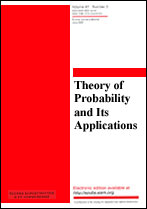|
This article is cited in 10 scientific papers (total in 10 papers)
Asymptotic near-minimaxity of the randomized Shiryaev–Roberts–Pollak change-point detection procedure in continuous time
A. S. Polunchenko
Department of Mathematical Sciences, State University of New York at Binghamton, Binghamton, NY, USA
Abstract:
For the classical continuous-time quickest change-point detection problem it is shown that the randomized Shiryaev–Roberts–Pollak procedure is asymptotically nearly minimax-optimal (in the sense of Pollak [Ann. Statist., 13 (1985), pp. 206–227]) in the class of randomized procedures with vanishingly small false alarm risk. The proof is explicit in that all of the relevant performance characteristics are found analytically and in a closed form. The rate of convergence to the (unknown) optimum is elucidated as well. The obtained optimality result is a one-order improvement of that previously obtained by Burnaev, Feinberg, and Shiryaev [Theory Probab. Appl., 53 (2009), pp. 519–536] for the very same problem.
Keywords:
minimax optimality, optimal stopping, quasi-stationary distribution, sequential change-point detection, Shiryaev–Roberts procedure.
Received: 30.03.2017
Accepted: 28.06.2017
Citation:
A. S. Polunchenko, “Asymptotic near-minimaxity of the randomized Shiryaev–Roberts–Pollak change-point detection procedure in continuous time”, Teor. Veroyatnost. i Primenen., 62:4 (2017), 769–786; Theory Probab. Appl., 62:4 (2018), 617–631
Linking options:
https://www.mathnet.ru/eng/tvp5142https://doi.org/10.4213/tvp5142 https://www.mathnet.ru/eng/tvp/v62/i4/p769
|


| Statistics & downloads: |
| Abstract page: | 551 | | Full-text PDF : | 76 | | References: | 62 | | First page: | 20 |
|




 Contact us:
Contact us: Terms of Use
Terms of Use
 Registration to the website
Registration to the website Logotypes
Logotypes








 Citation in format
Citation in format 
